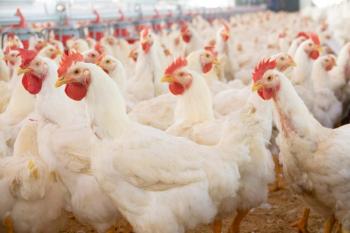
Avian clinical pathology (Proceedings)
The biochemical profile helps the veterinarian evaluate a patient's metabolic status through three specific groups of tests (metabolites, tissue enzymes and electrolytes).
The biochemical profile helps the veterinarian evaluate a patient's metabolic status through three specific groups of tests (metabolites, tissue enzymes and electrolytes). This paper will provide an overview of normal and abnormal analyte values within the biochemical profile and how these help the clinician rule-in or rule-out specific diseases or disease syndromes.
Serum and Plasma proteins
Total protein concentrations in birds (3.5-5.5 g/dl) are approximately half of those of mammalian species.1 Abnormal protein levels are the result of dehydration, dyscrasias (presence of abnormal proteins) or dysproteinemias (abnormal protein concentrations or abnormal proteins in the blood). Age and stage of development may also have an influence protein concentrations.2-4
Dysproteinemias
Hyperproteinemias most commonly results from dehydration, inflammatory conditions which show a reduced albumin-globulin ration (A:G ratio), hypergammaglobulinemia (chronic inflammatory conditions) and lymphoproliferative diseases (avian leukosis in chickens or myelosis in budgerigars).1,5 Hyperproteinemia with a normal A:G ration is indicative of dehydration. Estrogen may cause an increase in globulins in females that are preparing to lay.5 Chronic diseases such as psittacosis, egg yolk peritonitis, and tuberculosis may also cause an increase in protein levels.
Decreased plasma protein levels may occur in response to hemorrhage, protein losing enteropathy, nephropathy or dermatopathy, chronic hepatic disease, malabsorption or maldigestion, cachexia, malnutrition/starvation, lymphoid hypoplasia or aplasia as in psittacine circovirus infections (PBFD) and parsitism.5-7 Fibrinogen levels are not commonly performed; however, they may increase with dehydration or inflammation and may be a valuable indicator of bacterial infection and other inflammatory conditions in various species of birds (including several Amazon parrot and macaw species) as it is in mammals.6 Hypofibrinogenemia may be indicative of hepatic disorders or coagulopathies; however, the its significance has not be evaluated in psittacine species.
Plasma Protein Electrophoresis
Protein electrophoresis (PE) is considered to be the most reliable and accurate method of assessing protein concentrations in birds.8 Five major protein fractions are identified in birds including: pre-albumin, albumin, α1, α2, β1, β2 and γ-globulins.5,8 In avian species only one or two alpha fractions and a single fraction for beta and gamma proteins are typical.8
The following table by Werner and Reavil summarizes the changes and associated disease states one might detect by PE:9
Changes and associated disease states
Calcium
Plasma calcium concentrations consist of several a protein bound fraction (bound to albumin) a fraction bound to anionic compounds (citrate, bicarbonate, phosphate, or lactate) and a free (ionized portion).1,10,11
Most alterations of plasma calcium concentrations are related to nutritional disease(s). Hypercalcemia may be the result from egg production (increased carrier proteins), hypervitaminosis D (macaw species), primary hyperparathyroidism and pseudohyperparathyroidism, osteolytic tumors, dehydration, excessive supplementation and some plant toxicoses. 1,7,12,13 Artifactual increases in calcium concentrations may result from hemolysis, bacterial contamination of blood/plasma, samples1 or as a consequence of lipemia associated with ovulation or hepatic disease. Calcium levels should always be interpreted with knowledge of plasma albumin concentrations.
Hypocalcemia may arise from hypoalbuminemia, hypoparathyroidism, secondary nutritional or renal hypoparathyroidism and hypovitaminosis D. A hypocalcemic condition of African grey parrots has been frequently documented in the literature.5,12 Although the exact etiology of this condition is uncertain, dysfunctional parathyroid glands or parathyroid hormone (PTH) are suspected as possible etiologies.14
Cholesterol
Reference ranges for cholesterol in avian species vary greatly; however, normal plasma ranges are approximately 180-250 mg/dl.1 Hypocholesterolemia may result from hepatic insufficiency, decreased cholesterol synthesis resulting from severe liver disease or malnutrition, bacterial septicemia (E. coli endotoxemia), spirochetosis, toxicoses (aflatoxicosis) and decreased fat in the diet.7
Increased cholesterol concentrations are associated with lipemia in several psittacine species (macaws, rose-breasted cockatoos and Amazon parrots) with hepatic lipidosis, other forms of liver disease, hypothyroidism, bile duct obstruction, starvation, high fat diets, xanthomatosis, atherosclerosis, hypothyroidism, diabetes mellitus and high fat diets. 1,5,10,15
Glucose
Mild hyperglycemia is often the result of stress in avian species while significant elevations are caused by diabetes mellitus, egg related peritonitis (transient elevations), medical therapy (administration of fluids with dextrose or glucocorticoid administration.5,16
Hypoglycemia is associated with malnutrition (starvation), hepatic disease, septicemia, neoplasia, infectious/inflammatory diseases, malabsorptive disorders urinary disease and bacterial contamination of blood samples.5,15
Phosphorous
Hyperphosphatemia may develop from urinary disease, excessive dietary PO4, nutritional secondary hyperparathyroidism, artifact (hemolysis), leakage from devitalized intestinal mucosa, osteolytic bone lesions and severe tissue trauma.5 Hypophosphatemia may result from decreased dietary intake (anorexia), hypovitaminosis D3, diabetes ketoacidosis, primary hyperparathyroidism, pseudohyperparathyroidism, presence of PO4 binding agents (iatrogenic) and long-term glucocorticoid therapy. Changes in phosphorous levels do not always occur consistently with disease so the diagnostic value is poor. 5,7
Urea Nitrogen
Unlike mammals, urea nitrogen (UN) occurs in only small amounts in avian plasma, is excreted by glomerular filtration (100%), and is not a particularly useful indicator of renal function in birds.17,18 However, there is some indication that urea is significantly affected by the patient's hydration status as it is 99% reabsorbed in the tubules during periods of dehydration and may be the single most useful indicator of prerenal (dehydration) causes of kidney disease in birds.18,19
Uric Acid
Uric acid (UA) is the major end product of protein breakdown in birds. It is produced and secreted in the liver, kidney and pancreas and eliminated by tubular secretion independent of glomerular filtration, water resorption and urine flow rate.18,19 Plasma uric acid levels are not highly dependent upon the patient's hydration status and reflect the functional capacity of the renal proximal tubules.20 Therefore, hyperuricemia may be an indicator of renal disease in avian species. Unfortunately, consistent hyperuricemia is most often seen late in renal disease thus somewhat limiting the diagnostic value of this test.17 Additionally, normal uric acid levels do not necessarily guarantee that the kidneys are healthy.17,21 Other factors may also affect uric acid levels such as age (juvenile birds may have lower UA levels than adults), diet (granivorous birds have 50% lower UA concentrations than carnivorous species), post-prandial increases in uric acid (carnivorous species), hyperuricemia associated with ovulation, and the presence of purine precursors from degraded body proteins.17,22-24 Hyperuricemia may also be associated with disease conditions such as articular gout (UA plasma levels may not always rise in association with visceral gout), severe tissue damage, starvation, hypovitaminosis-A induced damage to renal epithelium, nephrotoxic drugs and hypervitaminosis D3 induced renal damage may result in elevated plasma uric acid levels.17,25-28 Plasma uric acid levels within the range of 10-20 mg/dl should always be reevaluated.21
Plasma Urea:Uric acid ratios may be used to define pre- and post-renal azotemia because reabsorption of urea is disproportionally higher than uric acid, and therefore, this ratio should be high during dehydration and ureteral obstruction.29 Urea:uric acid = Urea [mmol/L] × 1000/Uric acid [µmol/L]
Creatinine
Creatinine is of questionable value in evaluating renal function in avian species because birds reportedly excrete creatine before its conversion to creatinine.29,30 Elevations in creatinine have been associated dehydration (pigeons) renal trauma or nephrotoxic drugs.29
Iron
Plasma iron levels are not commonly included in most avian biochemical profiles. Avian species such as mynah birds and toucans will develop hemosiderosis and hemochromatosis as the result of excessive iron in their diets; however, the clinical significance of determining plasma iron levels in psittacine birds has not been fully investigated.
Hepatic Enzymes
The detection of hepatocellular disease in psittacine species can be difficult due to the lack of a truly sensitive indicator of hepatic disease.
Alanine Aminotransferase (ALT)— ALT is a highly specific indicator of hepatocellular damage in mammals but not so in avian species.
Alkaline Phosphatase (ALP)—ALP may arise from several sources including the kidney, intestine (primarily the duodenum) and liver.5 Elevations in plasma ALP activity in birds are more commonly associated with osteoblastic activity, bone growth and repair, osteomyelitis, nutritional secondary hyperparathyroidism and ovulatory activity.31
Aspartate Aminotransferase (AST, SGOT)—AST is found in many tissues including the liver, heart, skeletal muscle, brain and kidney and should be interpreted with knowledge of creatinine kinase levels. Significant elevations in AST activity may occur with hepatocellular damage/necrosis, vitamin E, selenium or methionine deficiencies, pesticide and carbon tetrachloride intoxication, and muscle damage (mild increases).5,31,32 Decreased AST activity may suggest significantly decreased liver.33
Glutamate Dehydrogenase (GLDH)—GLDH is possible the most specific indicator of hepatocellular damage or necrosis.31 It is found in many tissues including liver, kidney, and brain of several species of birds including domestic fowl, turkey, and duck; however, elevations of GLDH activity as an indicator of hepatocellular necrosis has been reported as inconsistent in pet avian species.31
Gamma Glutamyl Transferase (GGT)—GGT is found in biliary and renal tubular epithelium. Increased GGT levels may be due to liver disease; however, it is considered to be insensitive and inconsistent in hepatic disease in avian species.
Lactate Dehydrogenase (LDH). Lactate Dehydrogenase occurs in most avian tissues, and although this enzyme is not specific for a particular organ, elevations in activity levels are most commonly associated with hepatic disease in psittacine species.1,5,31 The half-life of LDH is relatively short compared with AST so levels may change rapidly.
Amylase and Lipase
Sources of amylase include the pancreas, liver and small intestine.7 Increased levels are reportedly associated with acute pancreatitis and gastrointestinal disease, although some have found no consistent correlation between the severity and type of pancreatic lesion and plasma amylase concentrations.5,34 The most accurate method to diagnose pancreatic disease is biopsy and histopathologic evaluation.
Bile acids
Increased bile acids concentrations appear to be a sensitive indicator of hepatic disease and decreased hepatic function in birds. Generally, a 2-to-4 fold increase is indicative of decreased liver function.35,36 Markedly low bile acid levels may be indicative of hepatic cirrhosis.5 Decreased bile acid levels. Biopsy accompanied by histopathology or microbiology would be necessary to determine the etiology of a diseased liver.
Creatinine Kinase (CK)
Increased CK levels have been associated with muscle damage associated with neurologic disease, vitamin E and selenium deficiencies, heavy metal toxicity (lead), psittacosis, trauma and intramuscular injections.5 Bacterial contamination is the most likely cause of a decrease in CK levels.
Electrolytes
Plasma electrolytes should always be evaluated with knowledge of the birds the understanding of appetite and thirst, hydration status, previous or current therapy and disease.
Sodium—Hypernatremia is expected following increased dietary intake, dehydration, decreased thirst, salt poisoning, while hyponatremia is caused by renal or gastrointestinal loss, hypoadrenocorticism, water retention, chronic/end-stage hepatic disease, over-hydration (psychogenic polydipsia or excessive intravenous fluid administration).1,5 Hyperlipemia and hyperproteinemia may falsely lower sodium levels.5
Chloride—As plasma sodium levels increase or decrease so to does chloride concentrations.
Hyperchloremia is rarely detected in avian species.5 Hypochloremia , although rarely detected in birds, is indicative of metabolic alkalosis from regurgitation or vomiting, kidney disease or congestive heart failure.
Potassium—Metabolic or respiratory acidosis due to hypoadrenocorticism, severe tissue damage/necrosis, dehydration or hemolytic anemia typically will likely result in hyperkalemia.5 Decreased dietary intake, gastrointestinal loss (vomiting or diarrhea) or delayed sample processing may result in hypokalemia.5 Hyperproteinemia and hyperlipemia may lower potassium levels.5
Bicarbonate ([HCO3-]). Most labs measure the total CO2 levels as indicators of bicarbonate levels. Increased bicarbonate levels indicate metabolic alkalosis and decreased levels indicate metabolic acidosis.
References provided on request.
Newsletter
From exam room tips to practice management insights, get trusted veterinary news delivered straight to your inbox—subscribe to dvm360.





